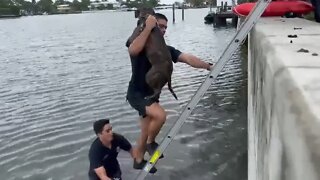Premium Only Content

What to Do at the Beach With Your Dog?
Most dogs love a warm sandy beach. One of the main reasons why most people carry their dogs to the beach is because of the open space and opportunity for them to run freely.
In an instant, he would be off like a rocket — leaping, twirling, bounding across the beach. Then he’d screech to a stop in a huge spray of sand, generally making a poodle fool of himself.
A visit to the beach is an ideal way to spend a summer day, and it can be tempting to take your dog along. But be aware the beach isn’t the best option for all dogs.
However, for the right dog, the beach can provide new sights, sounds, and smells to experience as well as opportunities for exciting games. However, there are doggie dangers, too. Maximize your fun by trying these activities, training these behaviors, and watching for these hazards.
You can do many of your dog’s favorite activities at the beach as well. For example, you can play tug-of-war or provide your dog with their favorite puzzle toy. But don’t miss out on all the opportunities for beach-related excitement. Here are some activities to try on your next beach outing:
Go for a walk. Explore the shore and let your dog soak in the new experiences like sniffing seaweed, watching scuttling crabs, or chasing seagulls. But don’t let your dog eat the seaweed or sand, both of which are dangerous for dogs to consume.
Play fetch on the beach with a ball or flying disc. Just be sure to choose a quiet spot so your dog’s enthusiasm for the game doesn’t disturb other beachgoers. Play fetch in the water. Choose a brightly colored floating toy so your dog can spot it on top of the waves. Be sure to play this game in relatively shallow water, as a bad throw can send your dog too far out from the shoreline.
Frolic together in the water. Splashing through the waves is a fun game, but your dog can easily overtire. So, stay close to shore and don’t leave your dog’s side. Go swimming. If they are new to the water, teach your dog to swim. Let them go at their own pace and fit them with a life jacket to provide extra confidence. But even experienced dogs need constant supervision to ensure they don’t overtire or swim too far from shore.
Teach your dog to surf or boogie board. If your dog is a confident swimmer, see if they might enjoy balancing on a board and surfing the waves. Learning to balance is also great for dog sports like agility or feeling comfortable in a canoe or kayak. Play in the sand. This is great for dogs who love to dig. Alternatively, you can build sandcastles and then let your dog destroy them.
Go boating together. If the water is calm enough, get your dog’s life jacket and try a canoe or kayak ride together. Whatever activities you decide to pursue, always supervise your dog. It’s important for your dog’s safety, but it’s also part of responsible dog ownership. Don’t let your dog disturb wildlife, damage vegetation, or become a nuisance to other people or dogs on the beach.
To ensure a safe and enjoyable beach day, there are certain behaviors your dog should know. First, your dog should have a reliable recall. Many beach activities require letting your dog off-leash, so you need to be certain your dog will come back to you when called. In fact, all your dog’s basic obedience behaviors should be under your control with either a hand signal or verbal cue. If your dog isn’t ready for that kind of freedom, stick to on-leash pursuits like walks along the shore. Leave it” is another important cue for your dog to understand. Leave it means your dog can’t eat something which could be garbage on the beach, a dead fish at the water’s edge, or food in somebody else’s picnic basket. With enough practice, this cue can also tell your dog to ignore something like wildlife or other beachgoers
Your dog should also be well-socialized and comfortable sharing toys with others. Beaches can get busy, and your dog might encounter loads of people and other dogs. For a social butterfly, that’s all part of the fun. However, if your dog is uncomfortable around people or other dogs, choose quiet times to visit the beach, such as earlier on a weekday morning, rather than times of peak attendance. There are some obvious dangers at the beach like rough waves, but you might not be aware of other hazards like drinking salt water. There are also rules to follow like leash laws and scooping poop. The following list will help you know what to watch for at the beach.
Check the rules. Not all beaches and swimming areas allow dogs. And some locations only allow them on certain days or at certain times. It’s also important to follow the leash regulations. Your dog might be allowed off-leash in some areas but not others. Watch for heatstroke. Provide your dog with shade and plenty of chances to rest. You might also limit your beach visits to early or late in the day when the sun isn’t as strong.
A visit to the beach is an ideal way to spend a summer day, and it can be tempting to take your dog along. But be aware the beach isn’t the best option for all dogs.
However, for the right dog, the beach can provide new sights, sounds, and smells to experience as well as opportunities for exciting games. However, there are doggie dangers, too. Maximize your fun by trying these activities, training these behaviors, and watching for these hazards.
What to Do at the Beach With Your Dog?
You can do many of your dog’s favorite activities at the beach as well. For example, you can play tug-of-war or provide your dog with their favorite puzzle toy. But don’t miss out on all the opportunities for beach-related excitement. Here are some activities to try on your next beach outing:
Go for a walk. Explore the shore and let your dog soak in the new experiences like sniffing seaweed, watching scuttling crabs, or chasing seagulls. But don’t let your dog eat the seaweed or sand, both of which are dangerous for dogs to consume.
Play fetch on the beach with a ball or flying disc. Just be sure to choose a quiet spot so your dog’s enthusiasm for the game doesn’t disturb other beachgoers.
Play fetch in the water. Choose a brightly colored floating toy so your dog can spot it on top of the waves. Be sure to play this game in relatively shallow water, as a bad throw can send your dog too far out from the shoreline.
Frolic together in the water. Splashing through the waves is a fun game, but your dog can easily overtire. So, stay close to shore and don’t leave your dog’s side.
Go swimming. If they are new to the water, teach your dog to swim. Let them go at their own pace and fit them with a life jacket to provide extra confidence. But even experienced dogs need constant supervision to ensure they don’t overtire or swim too far from shore.
Teach your dog to surf or boogie board. If your dog is a confident swimmer, see if they might enjoy balancing on a board and surfing the waves. Learning to balance is also great for dog sports like agility or feeling comfortable in a canoe or kayak.
Play in the sand. This is great for dogs who love to dig. Alternatively, you can build sandcastles and then let your dog destroy them.
Go boating together. If the water is calm enough, get your dog’s life jacket and try a canoe or kayak ride together.
Whatever activities you decide to pursue, always supervise your dog. It’s important for your dog’s safety, but it’s also part of responsible dog ownership. Don’t let your dog disturb wildlife, damage vegetation, or become a nuisance to other people or dogs on the beach.
Training Your Dog Should Know for a Beach Outing
To ensure a safe and enjoyable beach day, there are certain behaviors your dog should know. First, your dog should have a reliable recall. Many beach activities require letting your dog off-leash, so you need to be certain your dog will come back to you when called. In fact, all your dog’s basic obedience behaviors should be under your control with either a hand signal or verbal cue. If your dog isn’t ready for that kind of freedom, stick to on-leash pursuits like walks along the shore.
“Leave it” is another important cue for your dog to understand. Leave it means your dog can’t eat something which could be garbage on the beach, a dead fish at the water’s edge, or food in somebody else’s picnic basket. With enough practice, this cue can also tell your dog to ignore something like wildlife or other beachgoers.
Your dog should also be well-socialized and comfortable sharing toys with others. Beaches can get busy, and your dog might encounter loads of people and other dogs. For a social butterfly, that’s all part of the fun. However, if your dog is uncomfortable around people or other dogs, choose quiet times to visit the beach, such as earlier on a weekday morning, rather than times of peak attendance.
What to Watch for When at the Beach With Your Dog
There are some obvious dangers at the beach like rough waves, but you might not be aware of other hazards like drinking salt water. There are also rules to follow like leash laws and scooping poop. The following list will help you know what to watch for at the beach:
Check the rules. Not all beaches and swimming areas allow dogs. And some locations only allow them on certain days or at certain times. It’s also important to follow the leash regulations. Your dog might be allowed off-leash in some areas but not others.
Watch for heatstroke. Provide your dog with shade and plenty of chances to rest. You might also limit your beach visits to early or late in the day when the sun isn’t as strong.
Apply sunscreen to your dog. Dogs can suffer from sunburn, so use pet-safe sunscreen on your dog’s nose, ears, and any other areas with sparse fur.
Provide lots of fresh water. Your dog can easily dehydrate in the heat of summer, so frequently offer cool water to drink. Try to limit the amount of salt water your dog may drink as it can make them sick.
Prevent your dog from eating sand. It can block your dog’s intestines, causing an impaction.
-
 1:17
1:17
rumblestaff
3 years agoDog rescued after falling into bay at Miami Beach
1.02K2 -
 1:25:22
1:25:22
Kim Iversen
15 hours agoThe Real Target Of The LA Protests: YOUR FREEDOMS
66.9K168 -
 9:00
9:00
Adam Does Movies
13 hours agoBallerina Is Flopping Pretty Hard In Theaters
4.66K3 -
 LIVE
LIVE
BEK TV
14 hours agoTrent Loos in the Morning 6/10/2025
335 watching -
 LIVE
LIVE
Lofi Girl
2 years agoSynthwave Radio 🌌 - beats to chill/game to
1,602 watching -
 2:01:31
2:01:31
Side Scrollers Podcast
20 hours ago“Make FPS Great Again” MELTDOWN, Relooted ROASTED by EVERYONE + More | Side Scrollers Live
23.2K4 -
 LIVE
LIVE
The Sufari Hub
4 hours ago🔴MEETING THE BLACK CAT | MARVELS : SPIDER-MAN REMASTERED DLC | The City That NEVER Sleeps
43 watching -
 6:14:20
6:14:20
Biscotti-B23
7 hours ago $0.17 earned🔴 LIVE THOUSAND YEAR BLOOD WAR DLC EARLY ACCESS 🔥 RANKED MATCHES ⚔ BLEACH REBIRTH OF SOULS
12.8K -
 1:59:22
1:59:22
The Michelle Moore Show
1 day ago'Death of A Lot of Things Now, War Empowers BAAL, Plan B Must Be Disarmed, This Will Make or Break President Trump' Guest, Lt. Mark Taylor: The Michelle Moore Show (June 9, 2025)
39K30 -
 LIVE
LIVE
Game Galaxy
7 hours agoGame Galaxy OSRS Hardcore Duo ✨
51 watching